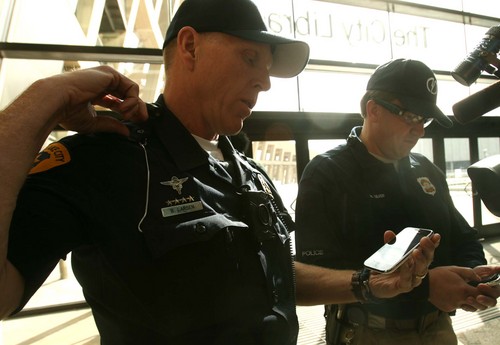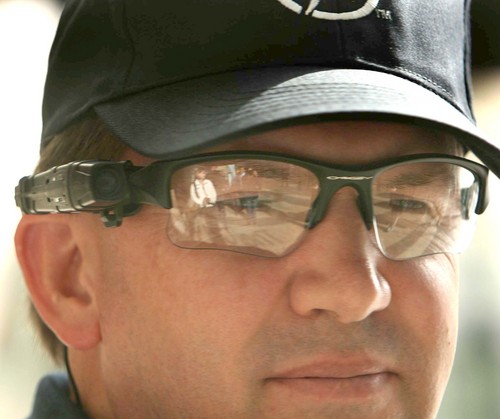This is an archived article that was published on sltrib.com in 2014, and information in the article may be outdated. It is provided only for personal research purposes and may not be reprinted.
As police face heightened scrutiny nationwide after controversial officer-involved shootings, law enforcement agencies and the public agree on at least one thing: Body cameras would be a big help.
"That's the thing of the future," said Ogden Police Lt. Will Cragun, whose department is testing demo cameras from several manufacturers. "We want to go down this road."
In Salt Lake County, body cameras are so desired that some Unified Police Department officers have bought them on their own, said UPD Lt. Justin Hoyal. "They use them on the job ... for documentation purposes."
Law enforcement officers may value video for different purposes than the public does. Footage may support or implicate officers whose actions are called into question, but more often it's used to show subjects' behavior in other criminal cases, said Brandon Poll, chief of the Davis County attorney's criminal division. Cams are widely distributed among Clearfield and West Bountiful police, Poll said.
"We use them day in and day out in cases where an interview is caught on a body cam and confirms what the officer says in a report," Poll said. "It's helpful for a jury to see the defendant has given three or four stories in just a 5-minute period."
In a recent case of resisting arrest, the video evidence cut both ways, Poll said. After several Clearfield police captured the arrest on body cams, the footage was used to prosecute one defendant — but cleared a second defendant, whose charges were dropped.
Outside police agencies, the shooting of unarmed teenager Michael Brown in Ferguson, Mo., has raised calls for body cams nationwide as a way to create transparency and accountability when police use force.
Body-cam video is now being reviewed in the fatal Aug. 11 shooting of Dillon Taylor outside a South Salt Lake convenience store by Salt Lake City police. SLCPD began issuing the cameras to patrol officers this year.
Police video has proved instrumental in evaluating officers' actions in several Utah shootings. In 2006, Utah Highway Patrol Trooper Ed Bentley was charged with assault in Carbon County after dash-cam video showed that robbery suspect John Gourno did not reach for a weapon before Bentley shot him. Charges later were dropped, but the shooting was deemed unjustified.
In the fatal 2010 shooting of Pollo Berumen in Clinton, a Taser-mounted camera captured "a perfect shot of the defendant running at [an officer] with a raised knife," said deputy Davis County prosecutor Jason Nelson. The officers were cleared.
Later in 2010, helmet-camera video was used to clear members of the Weber-Morgan Narcotics Task Force but raised controversy when footage was released showing a police officer shooting Todd Blair to death as he emerged from a hallway, holding a golf club above his head, moments after police broke through his door in a no-knock raid. The video has been viewed more than 290,000 times on YouTube.
The main barrier to body cams is cost: about $1,000 for each of 50 to 65 patrol officers in Ogden, Cragun said.
Different models have different assets and drawbacks. Ogden officers didn't like using the type Salt Lake City uses, which attach to hats or glasses, Cragun said. But cameras that clip to the chest may not capture relevant action if the officer's body is turned or arms are raised to fire a gun. The model being tested now provides high-quality images, but the data-storage method isn't compatible with the system the department now uses, Cragun said.
Data storage is a problem UPD is trying to address as Sheriff Jim Winder explores body-cam options, Hoyal said.
"It's complicated for evidence recovery and retention. We need servers to store information, download, and categorize all the different videos," Hoyal said. "There is a cost."
American Fork, Park City and Perry have supplied body cameras for officers.
West Valley City police had received a few through grant funding as of January and, thanks to additional grants, expect to have equipped the entire department by the end of the year or early next, said Chief Lee Russo. When he was the police chief of Covington, Ky., Russo equipped all of his officers with body cameras.
"We generally found there was a reduction of civil suits filed against the department," Russo said, noting that nine times out of 10, the camera protected the officer. On the flip side, they also expedite internal reviews in the event of officer misconduct, since officers didn't spend much effort to deny the allegations, he added.
Utah Highway Patrol is introducing body cameras to some troopers but puts more emphasis on dash cams as most of its activity is on Utah roadways, said spokesman Dwayne Baird.
Reporter Michael McFall contributed to this story.





